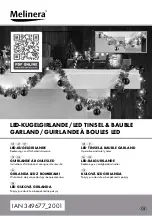
8
User's Guide Babyface Pro
© RME
The output channels 3/4 feed two
Phones
outputs via two independent driver circuits, optimized
for high (TRS 1/4”, 6.35mm) and low impedance (TRS 1/8”, 3.5mm) headphones. Their unbal-
anced output signal is – in terms of quality – identical to the ones at the XLR line outputs, but
lower in level.
In case the phones output is to be used as line output an adapter TRS plug to RCA phono
plugs, or TRS plug to two TS plugs is required. More on cable codes and pinouts can be found
in chapter 27.2.
The back of the unit has the XLR inputs and outputs of channels 1/2.
The short circuit protected, low impedance XLR line outputs do not operate servo bal-
anced! When connecting unbalanced equipment, make sure pin 3 of the XLR output is not
connected. A connection to ground might cause a decreased THD (higher distortion) and
increased power consumption!
The Babyface Pro has two analog
microphone
inputs that can operate as
line
inputs with lev-
els up to +19 dBu, when set to 0 dB gain and PAD active. The electronic input stage uses a
servo balanced design which handles unbalanced and balanced signals correctly, automatically
adjusting the level reference.
When using unbalanced cables with the XLR inputs pin 3 of the XLR jack should be con-
nected to ground. Otherwise noise may occur, caused by the unconnected negative input of
the balanced input.
The left side of the Babyface
Pro has an optical input and
output, a power supply
connector, a USB socket and
a 6-pin MINI DIN connector for
the included MIDI breakout
cable.
Optical I/O
(TOSLINK): The unit automatically detects SPDIF or ADAT input signals. The opti-
cal output can operate as ADAT or SPDIF output, depending on the current setting in the Set-
tings dialog.
USB 2.0
: Standard USB socket for connection to the computer. Please make sure the Babyface
Pro can have the full voltage/current delivered from the computer by using hi-quality USB ca-
bles (like the one included), no USB extension cables and no USB hubs. When connected to
USB 3 only the USB 2 protocol will be used.
Socket
for power connection. Unburdens the computer’s power supply, or ensures a stable
power supply, in case it proves to be insufficient when taken from the computer. This socket
supports locking type jacks as found on the optional RME DC power supply. After inserting the
connector carefully turn it by 90° so that it locks.
Содержание Babyface Pro
Страница 5: ...User s Guide Babyface Pro RME 5 User s Guide Babyface Pro General...
Страница 11: ...User s Guide Babyface Pro RME 11 User s Guide Babyface Pro Installation and Operation Windows...
Страница 28: ...28 User s Guide Babyface Pro RME...
Страница 29: ...User s Guide Babyface Pro RME 29 User s Guide Babyface Pro Installation and Operation Mac OS X...
Страница 38: ...38 User s Guide Babyface Pro RME...
Страница 39: ...User s Guide Babyface Pro RME 39 User s Guide Babyface Pro TotalMix FX...
Страница 41: ...User s Guide Babyface Pro RME 41...
Страница 73: ...User s Guide Babyface Pro RME 73 User s Guide Babyface Pro Technical Reference...
Страница 81: ...User s Guide Babyface Pro RME 81 27 Diagrams 27 1 Block Diagram Babyface Pro...
Страница 83: ...User s Guide Babyface Pro RME 83 User s Guide Babyface Pro Stand Alone and Class Compliant Mode...
Страница 91: ...User s Guide Babyface Pro RME 91 User s Guide Babyface Pro Miscellaneous...









































